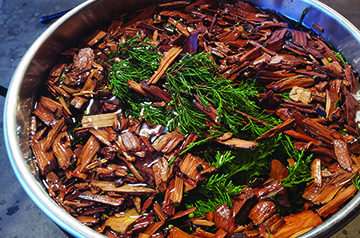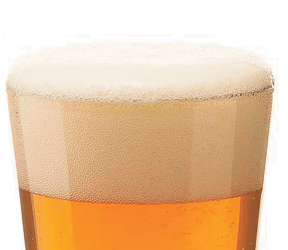American Gravøl
American Gravøl
(5 gallons/19 L, all-grain)
OG = 1.080 FG = 1.018
IBU = 15 SRM = 7 ABV = 8.2%

This recipe is brewed in a way that I feel pays homage to the ingredients and processes I saw being used in Norway. That’s not to say it doesn’t involve a lot of improvisation. I used kveik given to me by Ivar (which he got from Sigmund Gjernes), but commercially-available kveik (some of which come from Gjernes’ homestead) will result in a tasty beer too. The resulting beer was a highly aromatic and malty beer, dark orange-amber in color. It had very strong notes of smoke, pine, berries, citrus peel, and a rich malt sweetness.
Ingredients
12 lbs. (5.4 kg) Simpsons Best pale ale malt
2.25 lbs. (1 kg) applewood smoked malt
2.25 lbs. (1 kg) cherrywood smoked malt
3.5 AAU Hallertau Mittelfrüh hops (1 oz./28 g at 3.5% alpha acids) (first wort hop)
6–7 small branches of juniper (see Tips for Success)
1 lb. (0.45 kg) apple wood chips
Imperial A44 (Kveiking) or Omega OYL-061 (Voss Kveik) or The Yeast Bay WLP4045 (Sigmund’s Voss Kveik) or LalBrew Voss Kveik yeast
1⁄3 cup corn sugar (if priming)
Step by step
Prepare mash water by steeping juniper branches and apple wood chips in 7 gallons (26.5 L) of 160 °F (71 °C) water. Let steep for at least one hour to infuse flavor and color, stirring and punching down the cap frequently. If your steeping vessel doesn’t have a false bottom or other means of straining, remove juniper and apple wood chips with long-handled scoop or colander, and set aside.
Heat water to 170 °F (77 °C) for a mash temperature of 160 °F (71 °C). Mash grains for at least two hours at 160 °F (71 °C). (You could mash even longer if you’d like.)
During the long mash, bring sparge water to holding temperature and add back juniper and apple wood chips. Let steep to infuse flavor and color. After mash rest, remove the juniper and wood chips from the sparge water and sparge mash to collect at least 6 gallons (23 L) of wort in boil kettle. Add the first wort hops. Also collect 1–2 cups (240–480 mL) of this wort in a sanitized jar and add kveik flakes; stir several times to reconstitute into a pitchable slurry. Keep this at room temperature, if not warmer.
Boil collected wort for two hours then use a wort chiller (or cool naturally) to 103 °F (39 °C). Pitch rehydrated kveik slurry. Fermentation should start very quickly after (if not almost immediately upon) pitching this mini-starter of kveik slurry.
Allow temperature to drop to 90–95 °F (32–35 °C) and maintain that temperature. Check gravity and temperature every day. My beer fermented to 1.018 in three days with the yeast I used. Condition for one week at least. For packaging, go with a low carbonation level at around 1.5 volumes.
Tips for Success:
Gravøl is what Norwegians call a beer brewed for a funeral. Of course the passing of a loved one is a sad occasion to brew, however, the intense fermentation power of kveik makes it possible to make a beer quickly so that the deceased can be honored with a living brew. I brewed this beer for a dear friend whose father passed in October 2019. I drank and shared about a half-gallon (2 L) of the live beer straight from the fermenter to celebrate the traditional oppskåke I’d learned about in Norway. I bottled two gallons (8 L) of the very young beer between plastic PET bottles and flip-tops, and kegged the remaining beer.
Since I wouldn’t be brewing over an open fire, which would over the long boil impart a smokiness to the wort, I decided to use some apple and cherry wood smoked malt. Instead of the alderwood that is used traditionally in western Norway for steeping in the mash and sparge water, I used applewood chips (yep, the kind that you might use for grilling). I used about one pound (0.45 kg) of chips for the full 5-gallon (19-L) batch, but you could go with more if you’re not seeing a big color difference in your mash or sparge water. I was lucky enough to find a type of juniper tree in a local Minneapolis park that a forest guide friend uses for making wilderness teas so I felt safe using its branches and berries. Note that not all juniper and its relative family of cedar trees are safe to consume. Please take caution with both the juniper and wood chips. For the hops, go with a low-alpha acid variety; hops are not really for flavor here, more for some balance and preservation. We want to highlight the flavors of the kveik, juniper, and wood chips.
Check out this video for more discussion of process and tasting notes from Chop & Brew: https://bit.ly/americangravol
Written by Chip Walton




